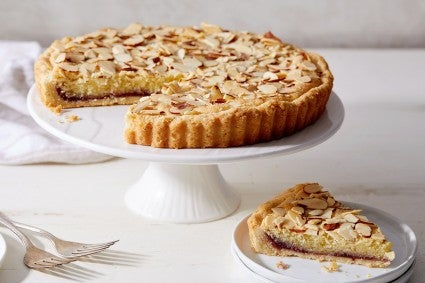What is frangipane and why do bakers love it so much?
This super-simple recipe is a baker’s secret weapon.


Ever wondered what makes an almond croissant so wonderful, or some fruit tarts so magically delicious? The secret is frangipane.

Wildly versatile, aromatic, and rich, frangipane is one of the best (and easiest!) recipes in a baker’s repertoire. To make it, softened butter, eggs, sugar, almond flour, a bit of all-purpose flour, and almond extract (or emulsion) are beaten together into a golden, spreadable paste. It takes all of five minutes to make, which is good news because there are so many wonderful ways to use it that you may find yourself wanting to make it all the time.
Because it contains raw egg and flour, frangipane is always baked before eating. It has a tendency to spread because of its high ratio of fat, so it’s typically used in applications where that’s limited, such as in a filling or topping. Frangipane is often used as a layer in fruit tarts; it puffs and browns beautifully as it bakes, swaddling the fruit, and I’m hard-pressed to think of a single fruit that isn’t enhanced by the almondy-whisper of frangipane, from cherries and peaches to apples and pears.

Frangipane is also a key component in Bakewell Tart, where it teams up with jam as a filling between layers of pastry. And it’s imperative in Bostock, a breakfast pastry made by saturating slices of day-old brioche with sugar syrup, then slathering on frangipane and baking until golden. (Bostock are usually, though not always, topped with fruit; a showering of toasted slivered almonds and confectioners’ sugar are typically added as finishing touches.) And this Almond Galette (aka Galette des Rois), a traditional French dessert typically served on Epiphany, is made with puff pastry and an almond cream filling that’s similar to frangipane; if you have some frangipane handy you can use it instead.

For a frangipane-forward non-recipe, try spreading it in a thick layer on puff pastry, then adding whatever fruit you have lying around (sliced nectarines, halved apricots, pitted cherries, blueberries or raspberries, thinly sliced apples or pears) and baking until the pastry and frangipane are golden brown and the fruit is tender. Or make your own ersatz almond croissants by splitting day-old plain croissants (homemade or storebought), spreading them with frangipane, and baking them a second time until crisp.

Should you be wondering, frangipane isn’t the same as marzipan, which is a denser, stiffer paste made primarily from almonds and sugar (no butter or eggs), that is often colored and formed into decorative shapes, and the two cannot be used interchangeably.
And while frangipane is typically made with ground almonds, it can be made with other ground nuts instead. Using pistachios will give you a verdant spread, while toasted and ground pecans yield a frangipane with a toffee-like flavor. Hazelnut frangipane pairs nicely with chocolate.
Frangipane keeps well, too: It will last a week in the refrigerator or up to two months frozen, so there’s no excuse for not always having some on hand, ready to dress up your next dessert.
Get this recipe: Frangipane
Shop this recipe: Almond Flour, Almond Extract, Almond Emulsion
Looking for a nut-free dessert instead? Watch us make the greatest lemon cake of all time.


